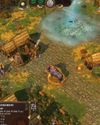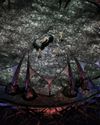
Nestled in the mist-shrouded mountains of rural China, Bailu Village is a settlement frozen in time. People live slow lives here among rice paddies, ornate Buddhist temples, quaint cottages, and fields of colorful wildflowers. There are some clues that Shenmue 3 is set in the 1980s – a woman’s oversized glasses, a bleepy arcade game – but otherwise, life here has changed very little in the past hundred years.
It’s an ideal setting for a Shenmue game, a series famous (or perhaps infamous) for its languid, aggressively deliberate pacing. This is a game as slow and meandering as the old man strolling through Bailu’s marketplace deciding which kind of steamed bun to have for lunch. And the village’s steadfast resistance to a changing world, to the creep of modernization, neatly reflects Shenmue 3’s position itself.
This unlikely sequel sticks so closely to the formula of the first two games that it’s almost as if the last 18 years of game design never happened. And honestly, as a fan, I couldn’t be happier. From its earliest days the Shenmue series has been divisive, with opinion rarely falling in the middle. You either think it’s an emotional, groundbreaking masterpiece or an indulgent, clunky mess. There’s no in-between.
If you belong to the latter camp, I’ll come right out and say it: Shenmue 3 won’t change your mind.
At all. The passage of time has only heightened the things that people criticise it for. The cumbersome controls, the abundance of cutscenes, the QTEs, the aching slowness of everything. But if you love these games for their idiosyncrasies, indefinable charm, sense of place and warmth, this is really as perfect a continuation of the series as you could hope for – with a few caveats.
This story is from the {{IssueName}} edition of {{MagazineName}}.
Start your 7-day Magzter GOLD free trial to access thousands of curated premium stories, and 9,000+ magazines and newspapers.
Already a subscriber ? Sign In
This story is from the {{IssueName}} edition of {{MagazineName}}.
Start your 7-day Magzter GOLD free trial to access thousands of curated premium stories, and 9,000+ magazines and newspapers.
Already a subscriber? Sign In

A New Dawn - The rise, fall and rise again of PC Gaming in Japan
The so-called 'Paso Kon' market (ie katakana's transliteration of 'Pasonaru Computa') in Japan was originally spearheaded in the 1980s by NEC's PC-8800 and, later, its PC-9800.

MARVEL: ULTIMATE ALLIANCE
Enter the multiverse of modness.

SLIDES RULE
Redeeming a hated puzzle mechanic with SLIDER

GODS AND MONSTERS
AGE OF MYTHOLOGY: RETOLD modernises a classic RTS with care

PHANTOM BLADE ZERO
Less Sekiro, more Wo Long: Fallen Dynasty

STARR-MAKING ROLE
Final Fantasy XVI's BEN STARR talks becoming a meme and dating summons

THIEF GOLD
Learning to forgive myself for knocking out every single guard.

HANDHELD GAMING PCs
In lieu of more powerful processors, handhelds are getting weirder

FAR FAR AWAY
STAR WARS OUTLAWS succeeds at the little things, but not much else shines

FINDING IMMORTALITY
Twenty-five years on, PLANESCAPE: TORMENT is still one of the most talked-about RPGs of all time. This is the story of how it was created as a ‘stay-busy’ project by a small team at Black Isle Studios